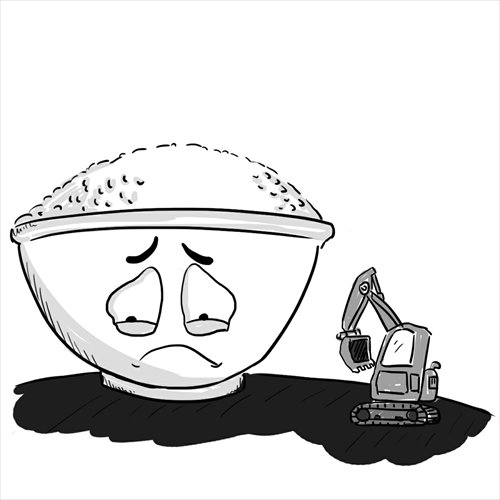Market diet needed to trim glutted industries

Illustration: Chen Xia/GT
China's long-standing problems with excessive capacity have only gotten more acute since the 2008 global financial crisis. In further acknowledgement of an increasingly untenable situation, the country's leaders promised unswerving effort to cut down overcapacity, according to statements issued Friday following the Central Economic Work Conference. This vow comes just weeks after the Third Plenary Session of the 18th Communist Party of China Central Committee, where the central leadership resolved to give the market greater say in the allocation of resources.
China's overall capacity utilization rate - a major gauge of overcapacity - eased to 57.8 percent last year, well below the historical average of roughly 73 percent set during the decades following 1978. And according to the National Bureau of Statistics, capacity utilization in heavy pillar sectors was only 78.6 percent at the end of the second quarter of 2013, meaning that 21.4 percent of capacity was idle.
To give a specific example, China's cement industry reportedly had 3.1 billion tons of production capacity and 2.21 billion tons of total output in 2012, representing about 900 million tons of excessive capacity. At the same time though, local cement companies were planning or in the midst of building 220 new cement production lines which would raise total annual capacity to 3.55 billion tons.
But capacity surplus isn't just plaguing backbone industries like electrolytic aluminum, steel and cement. Several emerging sectors are getting bogged down as well. At present, China's photovoltaic companies boast 40 gigawatts (gWs) of combined capacity, even though production still hovers around 21 gWs.
Although overcapacity is a normal (and in some ways beneficial) phenomenon present in all market economies - healthy levels of surplus, after all, can stir competition and optimize resource allocation - China's capacity woes have exceeded reasonable boundaries and are now major obstacles to economic development. Most of the excess is concentrated within capital-intensive industries with long investment cycles, characteristics which will make it difficult to trim the fat over the short term. But if nothing is done, troubled industries will face intensified operating pressure, reduced investment interest and limited credit availability. This toxic cocktail could quickly spread through whole industrial chains, potentially throwing China's largest sectors into a tailspin.
While special consideration should be given to factors like employment, bank assets and social stability when it comes to eliminating excess, effectively defusing China's overcapacity problems will require the government to adopt a fundamentally different role within the economy.
As has been well established, many local governments, capitalizing on resource distribution policies, have grown accustomed to dangling land and taxation incentives to attract capital. This has led to wasteful investment and redundant construction on a massive scale. For instance, official data show that 16 provinces and municipalities had tipped steel as a key development industry in their 12th Five-Year plans, while 20 put the automotive sector as a priority.
As the central leadership alluded to in recent reform documents, overcapacity is a pox best cured by market forces. Authorities should draw distinct boundaries between themselves and the market and allow enterprises to base their development strategies on their own market outlooks. Once the market has room to breathe, capacity will shrink or expand based on the dictates of supply and demand.
This will require the government to step away from its role as a solicitor and coordinator of investment. Again, as central policymakers have made clear, leaders will have to focus in the future on promoting fair competition, environmental protection and fostering innovation.
As this transformation picks up steam, relevant authorities should firstly try to keep economic growth steady so as to avoid overcapacity caused by disruptions to investment policy expectations.
Asymmetrical information gaps should also be ironed out, sooner rather than later, in order to prevent unnecessary construction in heavily saturated industries. Since government departments have certain advantages when it comes to information collection, processing and analysis, official functions in information services and guidance should be strengthened. Data disclosure systems should eventually be established to track key industries.
The local cadre review and assessment system should also be improved in order to discourage officials from pushing fixed asset investment beyond reasonable levels. Future evaluations should take into account efforts to keep unneeded capacity in check.
Finally, structural adjustments are needed to accelerate mergers and acquisitions. Opening the door to more consolidation will ease competition and shut down outdated capacity. Here, authorities would do well to perfect regulations pertaining to competition, bankruptcy and restructuring.
The author is an economist at Renmin University of China. bizopinion@globaltimes.com.cn